Ben Myers follows his debut collection of poetry, Elegy for Trains (winner of the Oklahoma Book Award), with the equally engaging Lapse Americana. As in his first collection, small town Oklahoma pulses with fairs, county dumps, summer jobs, holidays, Jesus, tragic commoners and such things Americana. In the hands of Myers, these themes breathe the hope of memory, but the disciplined line control of this poet does not allow memories of yesterday, of everyday, to overrun themselves.
A poet demonstrates control in the ability to avoid saying what need not be said, despite the urge to do so. In Lapse Americana, Myers performs a mature control by his refusal to over-speak a poem. I find his control reassuring and comforting — like collective silence at the end of a grand and moving film. Some examples:
- But there wasn’t a war then (xvi, line 35)
- and the men are dancing (20, line 23)
- When we leave, not only the children
are looking back
over shoulders into the shadowed
tent where Angel
is lighting his cigarette (22, lines 23-27) - There is a sky like sharpened bone
over the trailer home
with tinfoil in all the windows (24, lines 1-3) - I thought nothing
in Lincoln County still worked (26, lines 17-18) - Outside the wind
ripped through the ragged
arms of the cedars,
their red and shaggy roots
deep in alien clay (30, lines4-8) - Better that than waste
my last moments batting
after eloquence like a cat
after a June-bug (105, lines4-7)
Many times Myers successfully, artistically paints for me what is not there, and in that absence, I find so much speaking over and over again, reminding me, echoes lingering. Let me be clear, Myers is not merely Imagist, in the restricted, historical sense of that poetic movement; nor am I speaking of the mere sensation of “the sound of silence” to which we sometimes refer. I’m talking about technique –- control of a line for artistic effect. The poet’s refusal to tell all, his ability to lead us toward the image or theme merges with his insistence on stopping short. His scenes point without prattle. It is up to the reader to follow. Of course selection of details is perhaps the most challenging task for any writer in any genre. The tension between what is revealed and what is concealed makes art possible; and both under-stating and over-stating can interfere with the purity of dialogue a poet seeks with an audience. More often than not, Myers wonderfully strikes this balance. He leads readers into excursions of common memory. He takes them toward a profound sense of “I remember it; I feel it!”
Myers strikes the proper tones for his subject matter: somber, ironic, elegiac, musing, hopeful. He connects the everyday to Virgil and like Virgil he knows the depths of human potential. This knowledge, reined by his line integrity, invites readers to realize what he has realized. His lines compel us to see ourselves in his reflections offered as a gift, but a gift that requires our mutual attention to fulfill a dialogue. Like all fine and satisfying conversation, the variety of experiences represented by the various participants is enriching, when together, we reflect the life we hold in common.
Reviewed by Ken Hada, East Central University, Ada, Oklahoma
Benjamin Myers. Lapse Americana. New York: The New York Quarterly Foundation, Inc., 2013. ISBN 978-1-935520-71-9.
